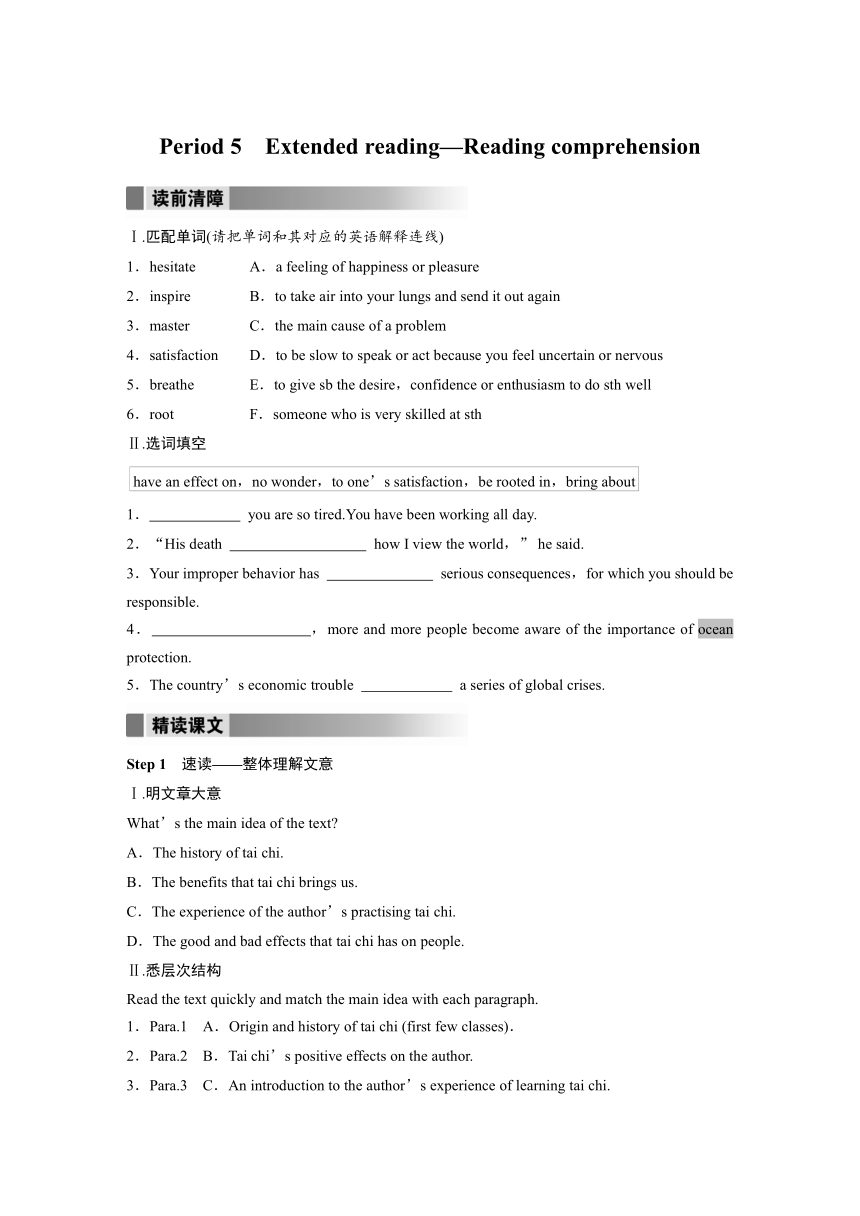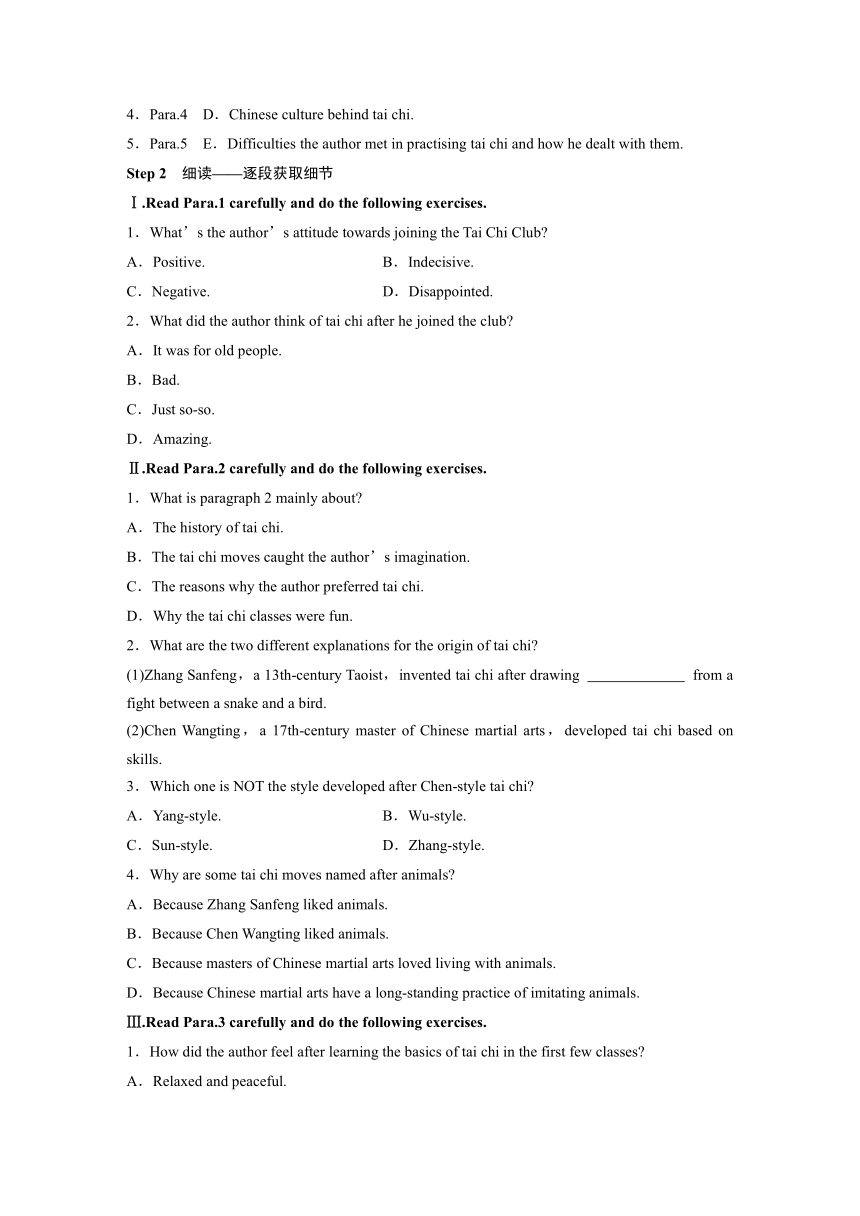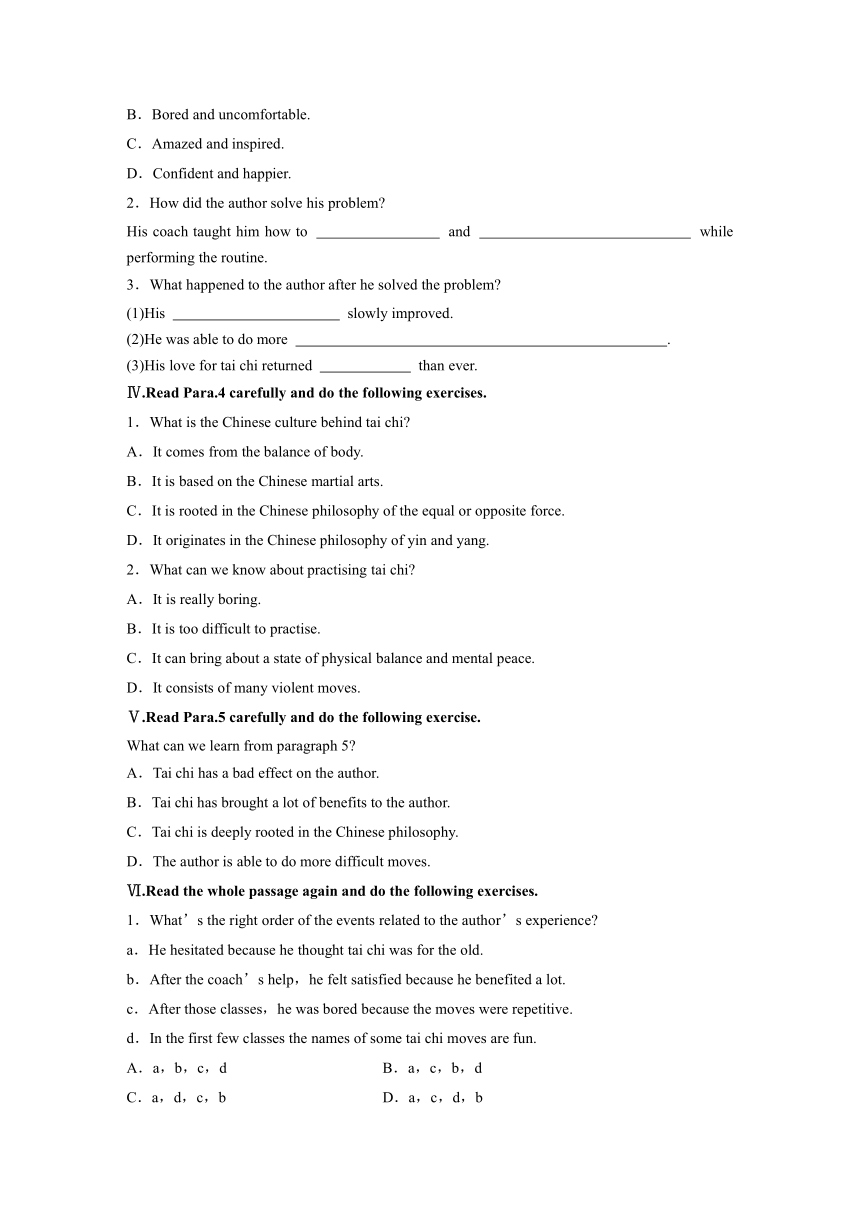牛津译林版(2019)必修 第二册Unit 2 Be sporty,be healthy Extended reading—Reading comprehension 学案(含答案)
文档属性
| 名称 | 牛津译林版(2019)必修 第二册Unit 2 Be sporty,be healthy Extended reading—Reading comprehension 学案(含答案) |  | |
| 格式 | docx | ||
| 文件大小 | 56.7KB | ||
| 资源类型 | 教案 | ||
| 版本资源 | 牛津译林版(2019) | ||
| 科目 | 英语 | ||
| 更新时间 | 2023-08-27 22:30:10 | ||
图片预览



文档简介
Period 5 Extended reading—Reading comprehension
Ⅰ.匹配单词(请把单词和其对应的英语解释连线)
1.hesitate A.a feeling of happiness or pleasure
2.inspire B.to take air into your lungs and send it out again
3.master C.the main cause of a problem
4.satisfaction D.to be slow to speak or act because you feel uncertain or nervous
5.breathe E.to give sb the desire,confidence or enthusiasm to do sth well
6.root F.someone who is very skilled at sth
Ⅱ.选词填空
1. you are so tired.You have been working all day.
2.“His death how I view the world,” he said.
3.Your improper behavior has serious consequences,for which you should be responsible.
4. ,more and more people become aware of the importance of ocean protection.
5.The country’s economic trouble a series of global crises.
Step 1 速读——整体理解文意
Ⅰ.明文章大意
What’s the main idea of the text
A.The history of tai chi.
B.The benefits that tai chi brings us.
C.The experience of the author’s practising tai chi.
D.The good and bad effects that tai chi has on people.
Ⅱ.悉层次结构
Read the text quickly and match the main idea with each paragraph.
1.Para.1 A.Origin and history of tai chi (first few classes).
2.Para.2 B.Tai chi’s positive effects on the author.
3.Para.3 C.An introduction to the author’s experience of learning tai chi.
4.Para.4 D.Chinese culture behind tai chi.
5.Para.5 E.Difficulties the author met in practising tai chi and how he dealt with them.
Step 2 细读——逐段获取细节
Ⅰ.Read Para.1 carefully and do the following exercises.
1.What’s the author’s attitude towards joining the Tai Chi Club
A.Positive. B.Indecisive.
C.Negative. D.Disappointed.
2.What did the author think of tai chi after he joined the club
A.It was for old people.
B.Bad.
C.Just so-so.
D.Amazing.
Ⅱ.Read Para.2 carefully and do the following exercises.
1.What is paragraph 2 mainly about
A.The history of tai chi.
B.The tai chi moves caught the author’s imagination.
C.The reasons why the author preferred tai chi.
D.Why the tai chi classes were fun.
2.What are the two different explanations for the origin of tai chi
(1)Zhang Sanfeng,a 13th-century Taoist,invented tai chi after drawing from a fight between a snake and a bird.
(2)Chen Wangting,a 17th-century master of Chinese martial arts,developed tai chi based on skills.
3.Which one is NOT the style developed after Chen-style tai chi
A.Yang-style. B.Wu-style.
C.Sun-style. D.Zhang-style.
4.Why are some tai chi moves named after animals
A.Because Zhang Sanfeng liked animals.
B.Because Chen Wangting liked animals.
C.Because masters of Chinese martial arts loved living with animals.
D.Because Chinese martial arts have a long-standing practice of imitating animals.
Ⅲ.Read Para.3 carefully and do the following exercises.
1.How did the author feel after learning the basics of tai chi in the first few classes
A.Relaxed and peaceful.
B.Bored and uncomfortable.
C.Amazed and inspired.
D.Confident and happier.
2.How did the author solve his problem
His coach taught him how to and while performing the routine.
3.What happened to the author after he solved the problem
(1)His slowly improved.
(2)He was able to do more .
(3)His love for tai chi returned than ever.
Ⅳ.Read Para.4 carefully and do the following exercises.
1.What is the Chinese culture behind tai chi
A.It comes from the balance of body.
B.It is based on the Chinese martial arts.
C.It is rooted in the Chinese philosophy of the equal or opposite force.
D.It originates in the Chinese philosophy of yin and yang.
2.What can we know about practising tai chi
A.It is really boring.
B.It is too difficult to practise.
C.It can bring about a state of physical balance and mental peace.
D.It consists of many violent moves.
Ⅴ.Read Para.5 carefully and do the following exercise.
What can we learn from paragraph 5
A.Tai chi has a bad effect on the author.
B.Tai chi has brought a lot of benefits to the author.
C.Tai chi is deeply rooted in the Chinese philosophy.
D.The author is able to do more difficult moves.
Ⅵ.Read the whole passage again and do the following exercises.
1.What’s the right order of the events related to the author’s experience
a.He hesitated because he thought tai chi was for the old.
b.After the coach’s help,he felt satisfied because he benefited a lot.
c.After those classes,he was bored because the moves were repetitive.
d.In the first few classes the names of some tai chi moves are fun.
A.a,b,c,d B.a,c,b,d
C.a,d,c,b D.a,c,d,b
2.Which word can best describe the author’s tai chi experience
A.Boring. B.Rewarding.
C.Surprising. D.Disappointing.
3.Where does this text probably come from
A.A newspaper.
B.A medical report.
C.A book review.
D.A TV interview.
Step 3 读后——讨论深度理解
1.How do you understand the unity of opposites (Critical Thinking批判性思维)
2.Write an application to the Tai Chi Club,and express your hope and your advantages.(Creative Thinking创造性思维)
Step 4 总结——课文语法填空
When my friend first suggested that we 1. (join) the new Tai Chi Club,I hesitated.After the first few classes,however,I had to admit that tai chi was 2. (amaze)! I can 3. (honest) say it has had a huge effect 4. me physically and mentally.5. (practise) tai chi has inspired me to explore the Chinese culture behind it.
Zhang Sanfeng was said 6. (invent) tai chi.However,nowadays people tend to believe that Chen Wangting developed tai chi 7. (base) on martial arts skills.Since Chinese martial arts have a long-standing practice of imitating animals,8. is not surprising that some tai chi moves 9. (name) after animals.I will continue to practise tai chi and enjoy the benefits 10. it has brought me.
Step 5 解读——长句难句分析
1.When my friend first suggested that we join the new Tai Chi Club at school,I hesitated.
[句式分析] 此句为 句。主句为 ;When引导 ,从句使用了虚拟语气,即谓语为 。
[自主翻译]
2.With these requirements of tai chi in mind,I found to my satisfaction that my balance and flexibility slowly improved,that I was able to do more difficult moves,and that my love for tai chi returned stronger than ever.
[句式分析] 此句为 句。With these requirements of tai chi in mind为with复合结构作 ;to my satisfaction意为“ ”;
主句的主语和谓语为 ,found后接三个that引导的 。
[自主翻译]
3.I discovered that tai chi is deeply rooted in the Chinese philosophy of yin and yang,which are believed to form the unity of opposites.
[句式分析] 此句为 句。主句主语和谓语为 ;that引导 ;be rooted in意为“ ”;which引导 。
[自主翻译]
4.Tai chi has taught me to relax my mind,enabling me to stay cool in stressful situations.
[句式分析] 此句为 句。此句主句为 ;enabling me to stay cool...为现在分词短语作 ,句子主语Tai chi与enable之间为 关系。
[自主翻译]
Period 5
读前清障
Ⅰ.1.D 2.E 3.F 4.A 5.B 6.C
Ⅱ.1.No wonder 2.has an effect on 3.brought about 4.To our satisfaction 5.is rooted in
精读课文
Step 1
Ⅰ.C
Ⅱ.1.C 2.A 3.E 4.D 5.B
Step 2
Ⅰ.1.D 2.D
Ⅱ.1.A
2.(1)inspiration (2)martial arts
3.D 4.D
Ⅲ.1.B
2.relax his muscles focus on peace of mind
3.(1)balance and flexibility (2)difficult moves (3)stronger
Ⅳ.1.D 2.C
Ⅴ.B
Ⅵ.1.C 2.B 3.A
Step 4
1.(should) join 2.amazing 3.honestly 4.on 5.Practising 6.to have invented 7.based 8.it 9.are named 10.that/which
Step 5
1.复合 I hesitated 时间状语从句 (should+)动词原形 一开始,当朋友建议我们加入学校新成立的太极拳俱乐部时,我犹豫了。
2.主从复合 伴随状语 令我欣慰的是 I found 宾语从句
将太极拳的这些要求铭记于心,慢慢地,我发现自己的平衡能力和柔韧性得到了改善,我能完成难度更大的动作,我对太极拳的热爱又回来了,而且比以前更强烈,这令我十分满意。
3.复合 I discovered 宾语从句 根源在于,由……产生 非限制性定语从句 我发现,太极拳深深地扎根于中国的阴阳学说之中,人们认为阴和阳构成了对立统一。
4.简单 Tai chi has taught me to relax my mind 结果状语 主动 太极拳让我学会了放松心态,使我在有压力的环境下也能冷静应对。
Ⅰ.匹配单词(请把单词和其对应的英语解释连线)
1.hesitate A.a feeling of happiness or pleasure
2.inspire B.to take air into your lungs and send it out again
3.master C.the main cause of a problem
4.satisfaction D.to be slow to speak or act because you feel uncertain or nervous
5.breathe E.to give sb the desire,confidence or enthusiasm to do sth well
6.root F.someone who is very skilled at sth
Ⅱ.选词填空
1. you are so tired.You have been working all day.
2.“His death how I view the world,” he said.
3.Your improper behavior has serious consequences,for which you should be responsible.
4. ,more and more people become aware of the importance of ocean protection.
5.The country’s economic trouble a series of global crises.
Step 1 速读——整体理解文意
Ⅰ.明文章大意
What’s the main idea of the text
A.The history of tai chi.
B.The benefits that tai chi brings us.
C.The experience of the author’s practising tai chi.
D.The good and bad effects that tai chi has on people.
Ⅱ.悉层次结构
Read the text quickly and match the main idea with each paragraph.
1.Para.1 A.Origin and history of tai chi (first few classes).
2.Para.2 B.Tai chi’s positive effects on the author.
3.Para.3 C.An introduction to the author’s experience of learning tai chi.
4.Para.4 D.Chinese culture behind tai chi.
5.Para.5 E.Difficulties the author met in practising tai chi and how he dealt with them.
Step 2 细读——逐段获取细节
Ⅰ.Read Para.1 carefully and do the following exercises.
1.What’s the author’s attitude towards joining the Tai Chi Club
A.Positive. B.Indecisive.
C.Negative. D.Disappointed.
2.What did the author think of tai chi after he joined the club
A.It was for old people.
B.Bad.
C.Just so-so.
D.Amazing.
Ⅱ.Read Para.2 carefully and do the following exercises.
1.What is paragraph 2 mainly about
A.The history of tai chi.
B.The tai chi moves caught the author’s imagination.
C.The reasons why the author preferred tai chi.
D.Why the tai chi classes were fun.
2.What are the two different explanations for the origin of tai chi
(1)Zhang Sanfeng,a 13th-century Taoist,invented tai chi after drawing from a fight between a snake and a bird.
(2)Chen Wangting,a 17th-century master of Chinese martial arts,developed tai chi based on skills.
3.Which one is NOT the style developed after Chen-style tai chi
A.Yang-style. B.Wu-style.
C.Sun-style. D.Zhang-style.
4.Why are some tai chi moves named after animals
A.Because Zhang Sanfeng liked animals.
B.Because Chen Wangting liked animals.
C.Because masters of Chinese martial arts loved living with animals.
D.Because Chinese martial arts have a long-standing practice of imitating animals.
Ⅲ.Read Para.3 carefully and do the following exercises.
1.How did the author feel after learning the basics of tai chi in the first few classes
A.Relaxed and peaceful.
B.Bored and uncomfortable.
C.Amazed and inspired.
D.Confident and happier.
2.How did the author solve his problem
His coach taught him how to and while performing the routine.
3.What happened to the author after he solved the problem
(1)His slowly improved.
(2)He was able to do more .
(3)His love for tai chi returned than ever.
Ⅳ.Read Para.4 carefully and do the following exercises.
1.What is the Chinese culture behind tai chi
A.It comes from the balance of body.
B.It is based on the Chinese martial arts.
C.It is rooted in the Chinese philosophy of the equal or opposite force.
D.It originates in the Chinese philosophy of yin and yang.
2.What can we know about practising tai chi
A.It is really boring.
B.It is too difficult to practise.
C.It can bring about a state of physical balance and mental peace.
D.It consists of many violent moves.
Ⅴ.Read Para.5 carefully and do the following exercise.
What can we learn from paragraph 5
A.Tai chi has a bad effect on the author.
B.Tai chi has brought a lot of benefits to the author.
C.Tai chi is deeply rooted in the Chinese philosophy.
D.The author is able to do more difficult moves.
Ⅵ.Read the whole passage again and do the following exercises.
1.What’s the right order of the events related to the author’s experience
a.He hesitated because he thought tai chi was for the old.
b.After the coach’s help,he felt satisfied because he benefited a lot.
c.After those classes,he was bored because the moves were repetitive.
d.In the first few classes the names of some tai chi moves are fun.
A.a,b,c,d B.a,c,b,d
C.a,d,c,b D.a,c,d,b
2.Which word can best describe the author’s tai chi experience
A.Boring. B.Rewarding.
C.Surprising. D.Disappointing.
3.Where does this text probably come from
A.A newspaper.
B.A medical report.
C.A book review.
D.A TV interview.
Step 3 读后——讨论深度理解
1.How do you understand the unity of opposites (Critical Thinking批判性思维)
2.Write an application to the Tai Chi Club,and express your hope and your advantages.(Creative Thinking创造性思维)
Step 4 总结——课文语法填空
When my friend first suggested that we 1. (join) the new Tai Chi Club,I hesitated.After the first few classes,however,I had to admit that tai chi was 2. (amaze)! I can 3. (honest) say it has had a huge effect 4. me physically and mentally.5. (practise) tai chi has inspired me to explore the Chinese culture behind it.
Zhang Sanfeng was said 6. (invent) tai chi.However,nowadays people tend to believe that Chen Wangting developed tai chi 7. (base) on martial arts skills.Since Chinese martial arts have a long-standing practice of imitating animals,8. is not surprising that some tai chi moves 9. (name) after animals.I will continue to practise tai chi and enjoy the benefits 10. it has brought me.
Step 5 解读——长句难句分析
1.When my friend first suggested that we join the new Tai Chi Club at school,I hesitated.
[句式分析] 此句为 句。主句为 ;When引导 ,从句使用了虚拟语气,即谓语为 。
[自主翻译]
2.With these requirements of tai chi in mind,I found to my satisfaction that my balance and flexibility slowly improved,that I was able to do more difficult moves,and that my love for tai chi returned stronger than ever.
[句式分析] 此句为 句。With these requirements of tai chi in mind为with复合结构作 ;to my satisfaction意为“ ”;
主句的主语和谓语为 ,found后接三个that引导的 。
[自主翻译]
3.I discovered that tai chi is deeply rooted in the Chinese philosophy of yin and yang,which are believed to form the unity of opposites.
[句式分析] 此句为 句。主句主语和谓语为 ;that引导 ;be rooted in意为“ ”;which引导 。
[自主翻译]
4.Tai chi has taught me to relax my mind,enabling me to stay cool in stressful situations.
[句式分析] 此句为 句。此句主句为 ;enabling me to stay cool...为现在分词短语作 ,句子主语Tai chi与enable之间为 关系。
[自主翻译]
Period 5
读前清障
Ⅰ.1.D 2.E 3.F 4.A 5.B 6.C
Ⅱ.1.No wonder 2.has an effect on 3.brought about 4.To our satisfaction 5.is rooted in
精读课文
Step 1
Ⅰ.C
Ⅱ.1.C 2.A 3.E 4.D 5.B
Step 2
Ⅰ.1.D 2.D
Ⅱ.1.A
2.(1)inspiration (2)martial arts
3.D 4.D
Ⅲ.1.B
2.relax his muscles focus on peace of mind
3.(1)balance and flexibility (2)difficult moves (3)stronger
Ⅳ.1.D 2.C
Ⅴ.B
Ⅵ.1.C 2.B 3.A
Step 4
1.(should) join 2.amazing 3.honestly 4.on 5.Practising 6.to have invented 7.based 8.it 9.are named 10.that/which
Step 5
1.复合 I hesitated 时间状语从句 (should+)动词原形 一开始,当朋友建议我们加入学校新成立的太极拳俱乐部时,我犹豫了。
2.主从复合 伴随状语 令我欣慰的是 I found 宾语从句
将太极拳的这些要求铭记于心,慢慢地,我发现自己的平衡能力和柔韧性得到了改善,我能完成难度更大的动作,我对太极拳的热爱又回来了,而且比以前更强烈,这令我十分满意。
3.复合 I discovered 宾语从句 根源在于,由……产生 非限制性定语从句 我发现,太极拳深深地扎根于中国的阴阳学说之中,人们认为阴和阳构成了对立统一。
4.简单 Tai chi has taught me to relax my mind 结果状语 主动 太极拳让我学会了放松心态,使我在有压力的环境下也能冷静应对。
